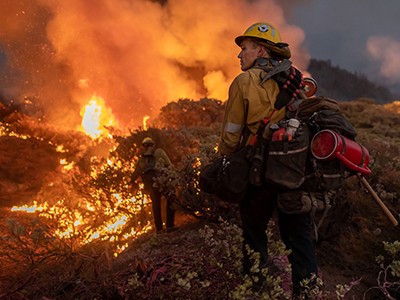In February, megafires ripped through the Chilean central coastal hills, killing at least 132 people, injuring hundreds and destroying 7,000 homes. At the time of writing, more than 300 people remain missing.
These wildfires are not a one-off calamity. You only need watch the news to know that wildfires are becoming more frequent and more destructive. Last year, catastrophic fires in Hawaii, Canada and Greece took hundreds of lives and caused widespread destruction. The 2019–20 Black Summer was the most uncontrolled fire season ever recorded in Australia. California’s 2018 Camp Fire was the deadliest ever in the state, and the most expensive natural disaster in the world that year. As a fire scientist at the Federal University of Rio de Janeiro in Brazil, I have lost track of how many times I have scrambled to analyse the deadly consequences of cataclysmic fires worldwide.
Countries need to take megafires more seriously and implement urgent programmes to mitigate the associated risks. That’s doesn’t just mean tackling the root causes of climate change. It means more-effective and consistent land- and fire-management policies, greater efforts to conserve native species and more education for local people on how to minimize risks.
Why is Latin America on fire? It’s not just climate change, scientists say
Climate change is a major driver of wildfires. Rising temperatures have increased the frequency, intensity and duration of extreme events such as droughts, heatwaves and high-speed winds, which fuel longer and wilder fires. The past few years have given us a bitter taste of the future of fires on a warming planet. Hotspot regions might face a tenfold increase in fire risk under future global warming.
But it isn’t just global warming that should be blamed, argues a 2022 report by the United Nations Environment Programme (see go.nature.com/3uwv9np) that I helped to author. Climate and land-cover changes, including deforestation, urbanization, mining and use of land for agriculture and pasture, have all increased the likelihood of extreme wildfires over the past decades.
The 2024 Chilean wildfires resulted from a complex interplay between extreme weather conditions and human behaviour, as we found in an attribution study (see go.nature.com/3tjjscy). Since 2010, central-south Chile has seen more frequent and larger wildfires, as well as a prolonged drought within what was the nation’s warmest decade recorded since 1970.
But, as in many other countries, key factors in boosting megafires are poor land management and the growing proximity of flammable vegetation to populated urban and suburban areas. The wildland–urban interface covers only 5% of Chile’s land surface, but is home to 80% of the country’s population — and 60% of its wildfires.
Land-cover changes have homogenized the landscape, and have increased the likelihood of megafires by removing natural fire barriers — native plants — and increasing the number of informal settlements near forests. Pasture and agricultural areas are typical ignition sources. Either accidentally or through negligence or arson, humans were responsible for around 98% of the known causes of Chilean fires between 1985 and 2018.

How record wildfires are harming human health
Worldwide, land management is underused as a means of reducing fire vulnerabilities and exposure. Prescribed burns are not a new wildfire-prevention technique, but they have been marginalized owing to negative public perception. For this to change, the first step would be to implement proper fire-management regulations that are firmly built on the necessity of prescribed burns. Good regulations, appropriate funding and adequate crew training are essential. Climate change has substantially decreased the number of days that provide favourable conditions for prescribed burns.
Prevention and regulation are a must, because once a megafire begins, it is almost impossible to snuff out, even with sophisticated methods. Policies focusing on reactive responses — such as fire suppression — could result in the ‘firefighting trap’, a positive feedback loop in which fire suppression leads to there being more dry fuel in the landscape, which leads to worse fires, requiring more suppression. Breaking this loop requires effective and continuous science–policy interaction.
Another important concern is human behaviour. Governments must pass and enforce laws that discourage people from starting fires when danger is elevated. But laws count for little without cultural change. To change hearts and minds, local governments, non-governmental organizations and companies can foster community engagement in fire prevention through education campaigns, and the media can systematically disseminate information to raise awareness of the consequences of irresponsible practices. Furthermore, fire-management plans should be embedded in local knowledge, and include the needs and concerns of Indigenous communities and smallholder farms.
Megafires are a humanitarian crisis. As a fire scientist, I always end my talks with a call to action: to implement a resilient fire-management strategy. Decelerating global warming isn’t enough. Nations need a holistic approach to fire governance, adjusting prevention, regulation and planning according to each local and ecological context.
Competing Interests
The author declares no competing interests.


